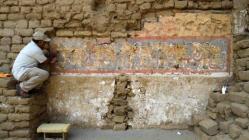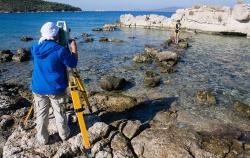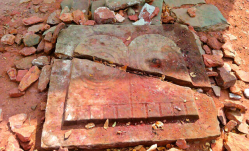INSTITUT SUPERIEUR D'ANTHROPOLOGIE
INSTITUTE OF ANTHROPOLOGY
ONLINE COURSES / COURS A DISTANCE
WINTER TERM : JANUARY 2016
REGISTER NOW
PEROU -  Huaca de la Luna - The discovery of a 1,500-year-old mural in northern Peru’s Huaca de la Luna archaeological site underscores the value of private investment. The mural features 10 human figures standing over five feet tall. Experts believe that the image depicts high priestesses or other women who played an important ceremonial role in the Moche religion. Archaeologists have discovered over 400 images featuring wild cats, birds and ocean waves which will be opened to the public in 2016.
Huaca de la Luna - The discovery of a 1,500-year-old mural in northern Peru’s Huaca de la Luna archaeological site underscores the value of private investment. The mural features 10 human figures standing over five feet tall. Experts believe that the image depicts high priestesses or other women who played an important ceremonial role in the Moche religion. Archaeologists have discovered over 400 images featuring wild cats, birds and ocean waves which will be opened to the public in 2016.
http://perureports.com/2015/11/09/mural-bolsters-case-for-private-investment-in-perus-archaeology/
CHINE – Guangzong - Two imperial edicts written on silk scrolls 540 years ago and 472 years ago in the Ming Dynasty (1368-1644) have been discovered in a villager's home in north China's Hebei Province. The imperial edicts, order or comment from emperors, are a family heirloom belonging to 80-year-old Cui Xibo, who showed them to researchers and archaeologists on Monday as local authorities conducted an archaeological survey in Guangzong County. One of the edicts, issued in the 11th year of Emperor Chenghua's reign, is 3.42 meters long and 33 centimeters wide and has 412 words, in which the emperor praised Cui's ancestor Cui Gong, the personnel minister at that time, for his hard work and diligence. The second, issued in the 22nd year of Emperor Jiajing's reign, is four meters long and 33 centimeters wide. In the 374 words of text, Cui Yue, grandson of Cui Gong and also an official, was promoted by the emperor. "The two imperial edicts share similar design and texture, and they will help us research how officials were appointed and promoted in the Ming Dynasty," said local historian Gu Huachi.nThe family treasures were handed down to the first son in each generation of Cui's family. "I'll keep handing them down. They record the great achievements of our ancestors and can encourage our offspring," Cui Xibo said.
http://news.xinhuanet.com/english/2015-11/10/c_134802701.htm?
TURQUIE -  Bademli - Archeologists have discovered an island mentioned in ancient books on which the ancient city of “Kane” was built, during surface explorations conducted near the Bademli neighborhood of Dikili, İzmir . After examining geological samples taken from layers of underground rock from a small peninsula near Bademli, the archeologists discovered that the peninsula was once an island in ancient times, and that the strait separating the island from the land had filled with silt over time. The newly discovered island is the third of the “Arginus” islands mentioned in ancient books. The location of the Arginus islands had been debated for some long time among archeologists, historians and geographers. Archeologists from the German Archeology Institute and the University of Köln along with historians, geographers and geophysicists from the universities of Manisa, Köln, Rostock and Southampton, started an archeological excavation to find the location of the Arginus islands near Bademli. Dr. Felix Pirson said: “It was not clear that these lands were actually the Arginus islands that we were looking for until our research. By examining the geological samples obtained through the core-drill method, we recognized that the gap between the third Arginus island and the mainland was indeed filled with loose soil and rock, creating the existing peninsula.” Through the examination of architectural remnants and ceramic artifacts on the peninsula, the archeologists discovered that the city of Kane was actually situated on the island.
Bademli - Archeologists have discovered an island mentioned in ancient books on which the ancient city of “Kane” was built, during surface explorations conducted near the Bademli neighborhood of Dikili, İzmir . After examining geological samples taken from layers of underground rock from a small peninsula near Bademli, the archeologists discovered that the peninsula was once an island in ancient times, and that the strait separating the island from the land had filled with silt over time. The newly discovered island is the third of the “Arginus” islands mentioned in ancient books. The location of the Arginus islands had been debated for some long time among archeologists, historians and geographers. Archeologists from the German Archeology Institute and the University of Köln along with historians, geographers and geophysicists from the universities of Manisa, Köln, Rostock and Southampton, started an archeological excavation to find the location of the Arginus islands near Bademli. Dr. Felix Pirson said: “It was not clear that these lands were actually the Arginus islands that we were looking for until our research. By examining the geological samples obtained through the core-drill method, we recognized that the gap between the third Arginus island and the mainland was indeed filled with loose soil and rock, creating the existing peninsula.” Through the examination of architectural remnants and ceramic artifacts on the peninsula, the archeologists discovered that the city of Kane was actually situated on the island.
http://www.todayszaman.com/national_missing-land-mentioned-in-ancient-books-discovered-by-archeologists-in-i-zmir_404012.html?
INDE –  Kadapa - : Two ‘biggest’ Buddha padhas have been found in Kadapa in Andhra Pradesh. An AP State Road Transport Corporation conductor turned archaeology enthusiast recently found the ‘biggest’ Buddha padhas and they were verified and dated by noted archaeologist Dr E. Siva Nagi Reddy. Siva Nagi Reddy the CEO of the cultural centre of Vijayawada said, “In the recent survey conducted by Y. Ramakrishna Reddy of APSRTC Proddutor depot and me we noticed the existence of the biggest Buddha padha slabs so far discovered in entire South India in Naganadhuni Kona. It is a newly discovered Buddhist site located three kms from Khajipet village in Mydukur mandal of YSR Kadapa district. The Buddhist site dates back to Satavahana times of 2nd century AD.” Informed by the locals Ramakrishna Reddy, Siva Nagi Reddy and engineer Chandrasekhar Reddy inspected the site and spotted the two Buddha padhas decorated with Astamangala symbols which are embossed in the compound wall of Siva temple on the hillock. Ramakrishna Reddy and his friend from Hyderabad had gone on a casual visit to the Siva temple earlier when local people informed them about digging by treasure hunters. They found large-size bricks 30 * 15 * 7 cms and foundations of circular stupas along with pot shreds. A request has been made to Archaeological Survey of India to protect the site and also to the police and MRO to protect it from treasure hunters.
Kadapa - : Two ‘biggest’ Buddha padhas have been found in Kadapa in Andhra Pradesh. An AP State Road Transport Corporation conductor turned archaeology enthusiast recently found the ‘biggest’ Buddha padhas and they were verified and dated by noted archaeologist Dr E. Siva Nagi Reddy. Siva Nagi Reddy the CEO of the cultural centre of Vijayawada said, “In the recent survey conducted by Y. Ramakrishna Reddy of APSRTC Proddutor depot and me we noticed the existence of the biggest Buddha padha slabs so far discovered in entire South India in Naganadhuni Kona. It is a newly discovered Buddhist site located three kms from Khajipet village in Mydukur mandal of YSR Kadapa district. The Buddhist site dates back to Satavahana times of 2nd century AD.” Informed by the locals Ramakrishna Reddy, Siva Nagi Reddy and engineer Chandrasekhar Reddy inspected the site and spotted the two Buddha padhas decorated with Astamangala symbols which are embossed in the compound wall of Siva temple on the hillock. Ramakrishna Reddy and his friend from Hyderabad had gone on a casual visit to the Siva temple earlier when local people informed them about digging by treasure hunters. They found large-size bricks 30 * 15 * 7 cms and foundations of circular stupas along with pot shreds. A request has been made to Archaeological Survey of India to protect the site and also to the police and MRO to protect it from treasure hunters.
http://www.deccanchronicle.com/151111/nation-current-affairs/article/biggest-buddha-%E2%80%98foot%E2%80%99-found-andhra-pradesh?